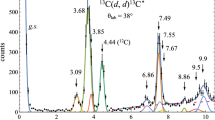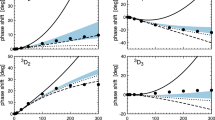Abstract
It has been customary to use data from the Oklo natural nuclear reactor to place bounds on the change that has occurred in the electromagnetic fine structure constant α over the last 2 billion years. Alternatively, an analysis could be based on a recently proposed expression for shifts in resonance energies which relates them to changes in both α and the average m q of the u and d current quark masses, and which makes explicit the dependence on mass number A and atomic number Z. (Recent model independent results on hadronic \({\sigma}\)-terms suggest sensitivity to the strange quark mass is negligible.) The most sophisticated analysis, to date, of the quark mass term invokes a calculation of the nuclear mean-field within the Walecka model of quantum hadrodynamics. We comment on this study and consider an alternative in which the link to low-energy quantum chromodynamics and its pattern of chiral symmetry-breaking is more readily discernible. Specifically, we investigate the sensitivity to changes in the pion mass \({M_\pi}\) of a single nucleon potential determined by an in-medium chiral perturbation theory (\({\chi}\)PT) calculation which includes virtual \({{\Delta}}\)-excitations. Subject to some reasonable assumptions about low-energy constants, we confirm that the m q -contribution to resonance shifts is enhanced by a factor of 10 or so relative to the \({\alpha}\)-term and deduce that the Oklo data for Sm imply that \({|m_q({\rm Oklo})- m_q({\rm now})| \lesssim 10^{-9}m_q({\rm now})}\).
Similar content being viewed by others
References
Dirac P.A.M.: The cosmological constants. Nature 139, 323 (1937)
Farmelo G.: The Strangest Man. Basic Books, New York (2009)
Uzan J.-P.: Varying constants, gravitation and cosmology. Living Rev. Relativ. 14, 2 (2011)
Webb, J.K., Murphy, M.T., Flambaum, V.V., Dzuba, V.A., Barrow, J.D., Churchill, C.W., Prochaska, J.X., Wolfe, A.M.: Further evidence for cosmological evolution of the fine structure constant. Phys. Rev. Lett. 87, 091301 (2001)
Webb, J.K., King, J.A., Murphy, M.T., Flambaum, V.V., Carswell, R.F., Bainbridge, M.B.: Indications of a spatial variation of the fine structure constant. Phys. Rev. Lett. 107, 191101 (2011)
Berengut J.C., Flambaum V.V.: Manifestations of a spatial variation of fundamental constants in atomic and nuclear clocks, Oklo, meteorites, and cosmological phenomena. Europhys. Lett. 97, 20006 (2012)
Herndon J.M.: Terracentric nuclear fission georeactor: background, basis, feasibility, structure, evidence and geophysical implications. Curr. Sci. 106, 528–541 (2014)
Davis E.D., Gould C.R., Sharapov E.I.: Oklo reactors and implications for nuclear science. Int. J. Mod. Phys. E 23, 1430007 (2014)
Müller A., Davis E.D., Harney H.-L.: Parity violation in compound-nucleus reactions. Phys. Rev. Lett. 65, 1329–1331 (1990)
Davis E.D., Hartmann U.: Nuclear sensitivity to time-reversal non-invariance: traditional detailed balance. Ann. Phys. (N.Y.) 211, 334–386 (1991)
Shlyakhter A.I.: Direct test of the constancy of fundamental nuclear constants. Nature 264, 340 (1976)
Chiba T.: The constancy of the constants of nature: updates. Prog. Theor. Phys. 126, 993–1019 (2011)
Onegin M.S., Yudkevich M.S., Gromin E.A.: Investigation of the fundamental constants stability based on the reactor Oklo burn-up analysis. Mod. Phys. Lett. A 27, 1250232 (2012)
Flambaum V.V., Wiringa R.B.: Enhanced effect of quark mass variation in 229Th and limits from Oklo data. Phys. Rev. C 79, 034302 (2009)
Kaiser N., Fritsch S., Weise W.: Chiral dynamics and nuclear matter. Nucl. Phys. A 697, 255–276 (2002)
Kaiser N., Fritsch S., Weise W.: Nuclear mean field from chiral pion–nucleon dynamics. Nucl. Phys. A 700, 343–358 (2002)
Fritsch S., Kaiser N., Weise W.: Chiral approach to nuclear matter: role of two-pion exchange with virtual delta-isobar excitation. Nucl. Phys. A 750, 259–293 (2005)
Damour T., Dyson F.J.: The Oklo bound on the time variation of the fine-structure constant revisited. Nucl. Phys. B 480, 37–54 (1996)
Dmitriev V.F., Flambaum V.V.: Limits on cosmological variation of quark masses and strong interaction. Phys. Rev. D 67, 063513 (2003)
Brockmann R., Weise W.: Spin-orbit coupling in a relativistic Hartree model for finite nuclei. Phys. Rev. C 16, 1282–1284 (1977)
Kaiser N., Gerstendörfer S., Weise W.: Peripheral NN-scattering: role of delta-excitation, correlated two-pion and vector meson exchange. Nucl. Phys. A 637, 395–420 (1998)
Finelli P., Kaiser N., Vretenar D., Weise W.: Relativistic nuclear model with point-couplings constrained by QCD and chiral symmetry. Nucl. Phys. A 735, 440–481 (2004)
Finelli P., Kaiser N., Vretenar D., Weise W.: Relativistic nuclear energy density functional constrained by low-energy QCD. Nucl. Phys. A 770, 1–31 (2006)
Epelbaum E., Hammer H.-W., Meißner U.-G.: Modern theory of nuclear forces. Rev. Mod. Phys. 81, 1773–1825 (2009)
Beane S.R., Savage M.J.: Variation of fundamental couplings and nuclear forces. Nucl. Phys. A 713, 148–164 (2003)
Beane S.R., Savage M.J.: The quark-mass dependence of two-nucleon systems. Nucl. Phys. A 717, 91–103 (2003)
Epelbaum E., Meißner U.-G., Glöckle W.: Nuclear forces in the chiral limit. Nucl. Phys. A 714, 535–574 (2003)
Bedaque P.F., Luu T., Platter L.: Quark mass variation constraints from big bang nucleosynthesis. Phys. Rev. C 83, 045803 (2011)
Berengut J.C., Epelbaum E., Flambaum V.V., Hanhart C., Meißner U.-G., Nebreda J., Peláez J.R.: Varying the light quark mass: impact on the nuclear force and big bang nucleosynthesis. Phys. Rev. D 87, 085018 (2013)
Epelbaum E., Krebs H., Lähda T.A., Lee D., Meißner U.-G.: Viability of carbon-based life as a function of the quark mass. Phys. Rev. Lett. 110, 112502 (2013)
Lutz M., Friman B., Appel C.: Saturation from nuclear pion dynamics. Phys. Lett. B 474, 7–14 (2000)
Bogner S.K., Furnstahl R.J., Schwenk A.: From low-momentum interactions to nuclear structure. Prog. Part. Nucl. Phys. 65, 94–147 (2010)
Author information
Authors and Affiliations
Corresponding author
Rights and permissions
About this article
Cite this article
Davis, E.D. Implications of the Oklo Phenomenon in a Chiral Approach to Nuclear Matter. Few-Body Syst 56, 431–437 (2015). https://doi.org/10.1007/s00601-014-0909-0
Received:
Accepted:
Published:
Issue Date:
DOI: https://doi.org/10.1007/s00601-014-0909-0




